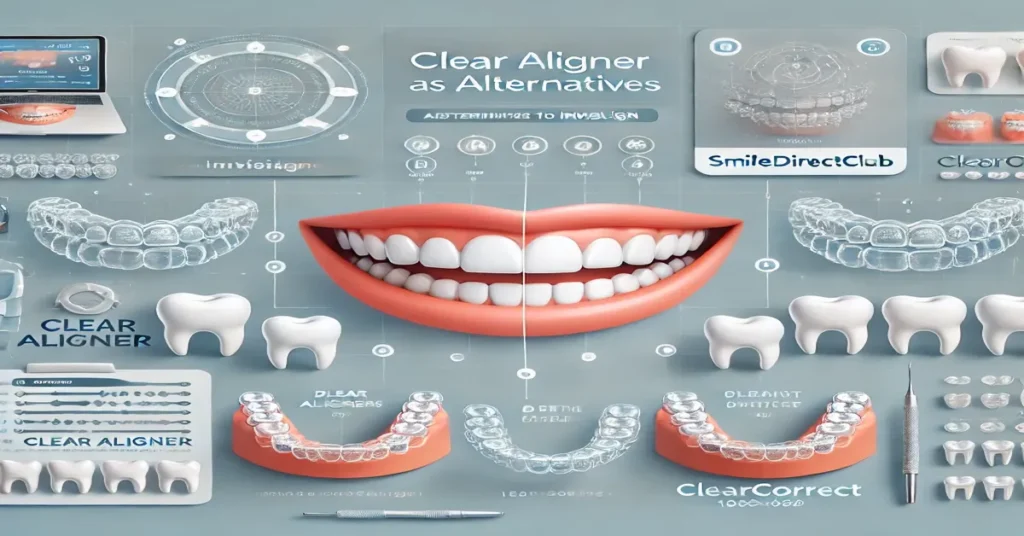Invisalign has become one of the most popular choices for clear aligner treatment, providing a nearly invisible way to straighten teeth without traditional braces. However, while Invisalign is well-known, it’s not the only clear aligner option available on the market. Many people may be looking for alternatives to Invisalign due to factors such as cost, treatment duration, or personal preferences. In this article, we’ll explore various Invisalign alternative, their unique benefits, potential downsides, and what to consider when choosing the best option for your orthodontic needs.
This comprehensive guide will cover:
- What clear aligners are and how they work.
- Reasons someone might look for an alternative to Invisalign.
- Detailed comparison of popular Invisalign alternatives.
- Factors to consider when choosing a clear aligner provider.
- Frequently asked questions to help you make an informed choice.
What Are Clear Aligners and How Do They Work?
Clear aligners are orthodontic devices that gradually move your teeth into their desired position. They are typically made from BPA-free plastic, designed to fit snugly over your teeth, and are custom-made to each patient’s specific dental structure. Clear aligners offer a discreet and comfortable alternative to metal braces and have become increasingly popular among teens and adults who want to improve their smiles without the visual and physical discomfort of traditional braces.
With clear aligners, patients wear a series of custom-made aligners over several months or years, depending on the treatment plan. Each set of aligners applies gentle pressure to specific teeth, gradually shifting them into place. Patients switch to a new set every one to two weeks as the teeth continue to move toward the ideal alignment.
Why Look for an Invisalign Alternative?
While Invisalign is a well-established brand with a strong track record, it may not be the ideal choice for everyone. Here are some common reasons why people look for alternatives to Invisalign:
1. Cost Concerns
Invisalign treatments can be quite expensive, with prices often ranging from $3,000 to $8,000. For those on a budget, the cost of Invisalign can be prohibitive, prompting them to search for more affordable options that still deliver effective results.
2. Convenience and Accessibility
Invisalign treatment typically requires regular visits to an orthodontist or dentist. For people with busy schedules or limited access to orthodontic care, this can be inconvenient. Some alternatives offer more remote or at-home options, making them accessible for those who prefer a more flexible treatment plan.
3. Treatment Complexity
While Invisalign is effective for mild to moderate orthodontic issues, complex cases may require traditional braces or alternative clear aligner systems designed to handle more severe alignment issues.
4. Faster Results
Some alternatives to Invisalign offer faster treatment times for minor misalignments, which can be appealing for those who want quicker results.
Popular Invisalign Alternatives
Let’s take a closer look at some popular alternatives to Invisalign. Each of these options has its own advantages, and some may be more suitable for specific needs or budgets.
1. SmileDirectClub
SmileDirectClub is one of the most well-known Invisalign alternatives, offering a more affordable at-home clear aligner treatment. It’s designed for mild to moderate teeth misalignment and is a good option for those looking for convenience.
- Cost: Around $2,000 – $2,500, significantly cheaper than Invisalign.
- Treatment Duration: Typically 4-6 months, depending on the case.
- Process: SmileDirectClub offers an initial impression kit or in-person scan at a SmileShop. The aligners are then shipped to your home, and progress is monitored remotely.
- Pros: Lower cost, shorter treatment time, and no in-office visits required.
- Cons: Limited to mild or moderate cases, less personalized care compared to in-office treatments.
2. Candid
Candid is another remote orthodontic provider that offers clear aligners for mild to moderate cases. What sets Candid apart is its hybrid approach, combining remote monitoring with in-office visits for initial evaluations, which some patients prefer for peace of mind.
- Cost: Approximately $2,400 – $3,500.
- Treatment Duration: Typically 6-9 months.
- Process: Patients visit a Candid Studio for an initial scan, and treatment is monitored remotely using the Candid app.
- Pros: Remote monitoring by orthodontists, hybrid model with initial in-office evaluation.
- Cons: Limited treatment scope, higher cost than some other at-home brands.
3. Byte
Byte is known for its accelerated treatment time and uses a device called HyperByte, which is a high-frequency vibration tool designed to reduce treatment time and improve comfort. Byte’s aligners are best for mild to moderate cases.
- Cost: Around $1,900 – $2,500.
- Treatment Duration: 3-6 months, with the HyperByte device.
- Process: Patients take an at-home impression kit, and aligners are shipped directly to them. Byte offers optional remote monitoring.
- Pros: Faster results, lifetime guarantee, and flexible payment plans.
- Cons: Limited to simpler cases, mostly remote with no in-person visits.
4. ClearCorrect
ClearCorrect is an in-office aligner option similar to Invisalign but at a lower cost. It’s often used by orthodontists and dentists as an alternative to Invisalign for patients with mild to complex cases.
- Cost: Approximately $2,500 – $5,500, depending on the treatment length.
- Treatment Duration: Similar to Invisalign, typically 12-24 months.
- Process: Treatment is managed by an orthodontist or dentist with regular in-office visits.
- Pros: Suitable for more complex cases, supervised by a dental professional.
- Cons: Higher cost compared to at-home options, requires in-office visits.
5. AlignerCo
AlignerCo is one of the most budget-friendly options for at-home clear aligner treatment, targeting mild cases of misalignment. It’s a popular choice for people who prioritize affordability.
- Cost: Around $1,145 – $1,350, one of the lowest on the market.
- Treatment Duration: Typically 6-11 months.
- Process: Patients take an at-home impression kit, and the aligners are shipped directly.
- Pros: Extremely affordable, no in-office visits required.
- Cons: Limited to mild cases, minimal interaction with professionals.
Factors to Consider When Choosing an Invisalign Alternative
Selecting the right clear aligner treatment depends on several factors, and understanding these can help you make an informed decision.
1. Severity of Misalignment
Mild to moderate cases can typically be handled by at-home or remote aligners, but more complex alignment issues may require in-office visits and close supervision. If you have severe misalignment, consult with a licensed orthodontist for the best options.
2. Budget and Financing Options
Costs can vary significantly among providers. Make sure to compare prices and financing options to find a treatment that fits your budget. Some companies offer monthly payment plans to make treatment more affordable.
3. Treatment Duration
Different aligner brands have varying treatment durations. If you want fast results, Byte with its HyperByte technology may be a good option. However, for those who need more extensive treatment, ClearCorrect or in-office options may be more effective.
4. Type of Monitoring
Remote monitoring can be convenient, but it might not be sufficient for more complex cases. Brands like Candid offer a hybrid model that includes both remote and in-office care, which could be beneficial if you prefer periodic in-person checkups.
5. Customer Support and Warranty
Some providers, like Byte, offer lifetime guarantees or satisfaction guarantees. Look for companies that provide good customer support, as clear aligner treatment requires consistent monitoring and adjustments.
Conclusion
Choosing the right alternative to Invisalign can offer you a cost-effective, convenient, and sometimes faster way to achieve a straighter smile. Each of the options discussed here has unique benefits and potential downsides, so it’s essential to assess your own needs, budget, and level of misalignment before making a decision. Remote clear aligners, such as SmileDirectClub, Byte, and AlignerCo, offer affordable and convenient treatment for mild cases, while in-office options like ClearCorrect cater to those needing more complex care.
While Invisalign is a trusted brand, these alternatives prove that you don’t need to limit your options. By exploring other aligner providers, you can find a solution that meets your orthodontic goals at a price point that works for you. Consult with a dental professional if you’re unsure about your treatment options, as their expertise can help guide you toward the best choice for your smile.
FAQs
1. Are Invisalign alternatives as effective as Invisalign?
Yes, many alternatives like ClearCorrect and Byte offer effective results for mild to moderate cases. However, the effectiveness depends on your specific needs and the provider.
2. Which Invisalign alternative is the most affordable?
AlignerCo is one of the most budget-friendly alternatives, with prices typically around $1,145, making it ideal for cost-conscious consumers.
3. How long do alternative aligners take compared to Invisalign?
Treatment time varies; Byte offers some of the fastest options at 3-6 months, while others like ClearCorrect may take up to 24 months.
4. Can I switch from Invisalign to an alternative provider?
Switching mid-treatment isn’t typically recommended as each provider customizes treatment plans. Speak with an orthodontist if you’re considering switching.
5. Do I need to visit an orthodontist for these alternatives?
Some alternatives like ClearCorrect require in-office visits, but options like SmileDirectClub and Byte offer fully remote treatment.
6. Are at-home aligners safe?
Yes, if provided by reputable companies, at-home aligners can be safe for mild to moderate cases. Always consult with a professional if you’re unsure about the treatment.







